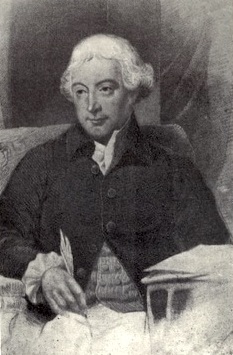Related Research Articles

The Bank of England is the central bank of the United Kingdom and the model on which most modern central banks have been based. Established in 1694 to act as the English Government's banker and debt manager, and still one of the bankers for the Government of the United Kingdom, it is the world's eighth-oldest bank.

Mervyn Allister King, Baron King of Lothbury is a British economist and public servant who served as the Governor of the Bank of England from 2003 to 2013. He is a School Professor of Economics at the London School of Economics. He is also the Chairman of the Philharmonia.

Events from the year 1745 in Canada.

Thomas Willing was an American merchant, politician and slave trader who served as mayor of Philadelphia and was a delegate from Pennsylvania to the Continental Congress. He also served as the first president of the Bank of North America and the First Bank of the United States. During his tenure there he became the richest man in America.

Brigadier-General Charles Lawrence was a British military officer who, as lieutenant governor and subsequently governor of Nova Scotia, is perhaps best known for overseeing the Expulsion of the Acadians and settling the New England Planters in Nova Scotia. He was born in Plymouth, England, and died in Halifax, Nova Scotia. According to historian Elizabeth Griffiths, Lawrence was seen as a "competent", "efficient" officer with a "service record that had earned him fairly rapid promotion, a person of considerable administrative talent who was trusted by both Cornwallis and Hopson." He is buried in the crypt of St. Paul's Church (Halifax).

Arthur Fenner was an American politician who served as the fourth Governor of Rhode Island from 1790 until his death in 1805. He has the seventh longest gubernatorial tenure in post-Constitutional U.S. history at 5,641 days. Fenner was a prominent Country Party (Anti-federalist) leader. Around 1764, Fenner joined several others as a petitioner for the chartering of the College in the English Colony of Rhode Island and Providence Plantations.

Mark Joseph Carney is a Canadian economist and banker who was the governor of the Bank of Canada from 2008 to 2013 and the governor of the Bank of England from 2013 to 2020. He is chair, and head of impact investing at Brookfield Asset Management since 2020, and was named chairman of Bloomberg Inc., parent company of Bloomberg L.P., in 2023. He was the chair of the Financial Stability Board from 2011 to 2018. Prior to his governorships, Carney worked at Goldman Sachs as well as the Department of Finance Canada. He also serves as the UN Special Envoy for Climate Action and Finance.

Andrew John Bailey is a British central banker and Governor of the Bank of England since 16 March 2020.
William Fawkener was Governor of the Bank of England from 1743 to 1745, having previously served as the Bank's Deputy Governor. He was son of another William Fawkener (1642–1716), a leading member of the Levant Company, and brother of Sir Everard Fawkener, who was also a merchant dealing in silk, before becoming Ambassador to the Sublime Porte between 1737 and 1744.

Joseph Cotton FRS, was an English mariner and merchant, a director of the East India Company and deputy-master of Trinity House.
Sir Edward Bellamy was a London banker who was Lord Mayor of London and Governor of the Bank of England
Delillers Carbonnel was an English banker who was Governor of the Bank of England from 1740 to 1741.
Benjamin Longuet was an English banker who served as Governor of the Bank of England from 1747 to 1749, and who was a director of the bank from 1734 until his death. He had been Deputy Governor from 1745 to 1747. He replaced Charles Savage as Governor and was succeeded by William Hunt.
Alexander Sheafe was the Governor of the Bank of England from 1752 to 1754. He had been Deputy Governor from 1750 to 1752. He replaced William Hunt as Governor and was succeeded by Charles Palmer.
Charles Palmer was Governor of the Bank of England from 1754 to 1756. He had been Deputy Governor from 1752 to 1754. He replaced Alexander Sheafe as Governor and was succeeded by Matthews Beachcroft.
Matthews Beachcroft was Governor of the Bank of England from 1756 to 1758. He had been Deputy Governor from 1754 to 1756. He replaced Charles Palmer as Governor and was succeeded by Merrick Burrell. Beachcroft's tenure as Governor occurred at the beginning of the Bengal bubble (1757–1769).
Robert Marsh was Governor of the Bank of England from 1762 to 1764. He had been Deputy Governor from 1760 to 1762. He replaced Bartholomew Burton as Governor and was succeeded by John Weyland. Marsh's tenure as Governor occurred during the Bengal bubble (1757–1769).
James Sperling was Governor of the Bank of England from 1773 to 1775. He had been Deputy Governor from 1771 to 1773. He replaced Edward Payne as Governor and was succeeded by Samuel Beachcroft. Sperling's tenure as Governor occurred during the Bengal bubble crash (1769–1784).
George Peters was Governor of the Bank of England from 1785 to 1787. He had been Deputy Governor from 1783 to 1785. He replaced Richard Neave as Governor and was succeeded by Edward Darell.
Godfrey Thornton was Governor of the Bank of England from 1793 to 1795. He had been Deputy Governor from 1791 to 1793. He replaced Samuel Bosanquet as Governor and was succeeded by Daniel Giles.
References
- ↑ Governors of the Bank of England. Archived 12 February 2012 at the Wayback Machine Bank of England, London, 2013. Archived here. Retrieved 14 February 2016.